
Top 100 Crypto Index: What It Is, How It’s Built, and Who It’s For (2025)
%201.svg)
%201.svg)


If you’ve tried to “own the market” in crypto, you’ve felt the pain: chasing listings, juggling wallets, and missing rebalances while prices move. A top 100 crypto index aims to fix that—giving you broad exposure when the market is bullish and standing down when it’s not. Token Metrics Global 100 is our rules-based version of that idea: it holds the top-100 by market cap in bull regimes, moves to stablecoins in bear regimes, and rebalances weekly. You can see every rule, every holding, and every rebalance—then buy the index in ~90 seconds with an embedded on-chain flow. → Join the waitlist to be first to trade TM Global 100.
Why a “Top 100 Crypto Index” Matters in October 2025
The market keeps cycling. New leaders emerge quickly. A “set-and-forget” bag can fall behind, while manual baskets burn hours and rack up slippage. Search interest for crypto index, regime switching, and weekly rebalancing keeps growing because people want a simple, disciplined core that adapts.
Definition (for featured snippets):
A top 100 crypto index is a rules-based basket that tracks the largest 100 crypto assets by market cap, typically rebalanced on a schedule to keep weights aligned with the market. In 2025, that alone isn’t enough. You also need discipline for downtrends. Token Metrics adds a regime-switching layer to move to stablecoins during bear phases—so you can participate in upside and sit out major drawdowns with a consistent, rules-based approach.
How the TM Global 100 Index Works (Plain English)
Regime switching:
- Bullish: The index holds the top-100 assets by market cap.
- Bearish: The index exits positions and moves fully to stablecoins until a bullish re-entry signal.
Weekly rebalancing:
- Every week, the composition and weights update to reflect current market-cap rankings. No manual list maintenance. No “oops, I missed the new entrant.”
Transparency:
- Strategy modal explains selection criteria and regime logic.
- Gauge → Treemap → Transactions Log shows the signal, the real-time holdings view, and every rebalance/regime switch.
You’ll always see what you own, how it changed, and why.
What you’ll see on launch
- Price tile, 100 tokens, “rebalances weekly,” and one-click Buy.
- Gauge to visualize the market signal.
- Holdings Treemap and Table to inspect exposure.
- Transactions Log to review every rebalance.
- See the strategy and rules.
Benefits at a Glance (Why This Beats DIY)
- Time saved: Skip hours of asset chasing and manual spreadsheets; rebalances happen automatically.
- Lower execution drag: One index buy can reduce slippage vs. piecing together 20–50 small orders across chains.
- Never miss a rebalance: Weekly updates and on/off risk switches run by rules, not vibes.
- Rules-based switching: A clear trigger defines when to sit in stablecoins—no second-guessing.
- Full visibility: The gauge, treemap, table, and log make the process auditable at a glance.
- Operational simplicity: An embedded wallet, 90-second buy flow, fee and slippage estimates upfront.
Step-by-Step: How to Get Early Access (Waitlist)
- Open the Indices hub and tap TM Global 100.
- Join the waitlist with your email—this flags you for day-one access.
- (Optional) Connect your wallet so you’re ready for the embedded checkout.
- Launch day: You’ll get an email and in-app prompt when trading opens.
- Buy in ~90 seconds: Connect, review fees/slippage/estimated value, confirm.
- Track positions: See your holdings, rebalances, and P&L in My Indices.
- Repeat or add funds: Rebalancing is handled weekly; you can add or sell anytime.
→ Join the waitlist to be first to trade TM Global 100.
Decision Guide: Is This Right for You?
- Hands-Off Allocator: Want broad market exposure without managing coin lists? Consider it.
- Active Trader: Want a disciplined core you don’t have to watch while you chase setups? Consider it.
- TM Member (Research-Heavy): Prefer to keep your picks, but want a market base layer? Consider it.
- New to Crypto: Need transparency + clear rules? Consider it, with a small test first.
- Hyper-Niche Maxi: If you only want 1–2 coins, an index may be too broad.
- Short-Term Scalper: You may still benefit from a core allocation, but active trading stays your main driver.
- Tax-/Jurisdiction-Sensitive Users: Check your local rules before investing.
- Institutional Explorers: Looking for transparent rules, logs, and weekly governance? Worth evaluating.
FAQs
What is a top 100 crypto index?
A rules-based basket tracking the largest 100 assets by market cap, typically with scheduled rebalancing. Token Metrics Global 100 adds regime switching to stablecoins during bear markets.
How often does the index rebalance?
Weekly. In addition, if the market signal flips, the entire portfolio may switch between tokens ↔ stablecoins outside the weekly cycle.
What triggers the move to stablecoins?
A proprietary market-regime signal. When it’s bearish, the index exits tokens to stablecoins and waits for a bullish re-entry signal.
Can I fund with USDC or fiat?
On launch, funding options surface based on your connected wallet and supported chains. USDC payouts are supported when selling.
Is the wallet custodial?
The embedded wallet is self-custodial—you control your funds.
How are fees shown?
Before you confirm a buy, you’ll see estimated gas, platform fee, max slippage, and minimum expected value—all up front.
How do I join the waitlist?
Go to the TM Global 100 page or the Indices hub and click Join Waitlist. You’ll get notified at launch with simple steps to buy.
Security, Risk & Transparency
- Self-custody: Embedded, self-custodial smart wallet; you control keys.
- 2FA & device checks: Standard authentication best practices.
- Fee/slippage transparency: All estimates are shown pre-trade; you confirm with eyes open.
- On-chain visibility: Holdings, rebalances, and regime switches appear in the Transactions Log.
- Rule constraints: Signals can be wrong; spreads and volatility can impact outcomes.
- Regional considerations: Availability and tax treatment vary by jurisdiction.
Crypto is volatile and can lose value. Past performance is not indicative of future results. This article is for research/education, not financial advice.
Conclusion + Related Reads
A top 100 crypto index is the simplest path to broad market exposure—if it’s built with discipline. Token Metrics Global 100 combines transparent rules, weekly rebalancing, and a regime switch to stablecoins, so you can focus on your strategy while the core maintains itself. Now’s the time to claim early access. → Join the waitlist to be first to trade TM Global 100.
AI Agents in Minutes, Not Months


.svg)



Create Your Free Token Metrics Account





.png)
Recent Posts

Best Crypto Liquidity Management & Market-Making Tools (2025)
%201.svg)
%201.svg)
Who this guide is for. Token teams, exchanges, funds, and DAOs comparing liquidity management and market-making tools to tighten spreads, balance inventories, and support healthy markets.
Top three picks.
- Flowdesk — compliance-first platform + MMaaS across 140+ venues. (flowdesk.co)
- Keyrock — full-stack liquidity (MM, OTC, LP mgmt, NFTs). (Keyrock)
- Wintermute — leading algorithmic liquidity partner across CeFi/DeFi. (wintermute.com)
One key caveat. Fees and engagement models vary widely (retainer, inventory loan/call, performance); confirm scope, reporting, and legal terms before signing. (flowdesk.co)
Introduction: Why Crypto Liquidity Management & Market-Making Tools Matter in November 2025
In crypto, liquidity management and market-making tools keep order books tight, reduce slippage, and stabilize price discovery across centralized and decentralized venues. The primary keyword here is liquidity management and market-making tools, and the right stack blends execution algorithms, risk controls, analytics, and clear reporting so projects can support listings and users can trade efficiently.
In 2025, onchain liquidity is increasingly concentrated and active on AMMs while institutions expect 24/7 coverage and API connectivity across spot, perps, and options. Mature providers now offer compliance-forward processes, automated vaults for concentrated liquidity, and multi-venue execution with transparent documentation. This guide ranks ten credible options, explains trade-offs (costs, custody, venues), and gives you a practical checklist to choose confidently.
Best Crypto Liquidity Management & Market-Making Tools in November 2025 (Comparison Table)
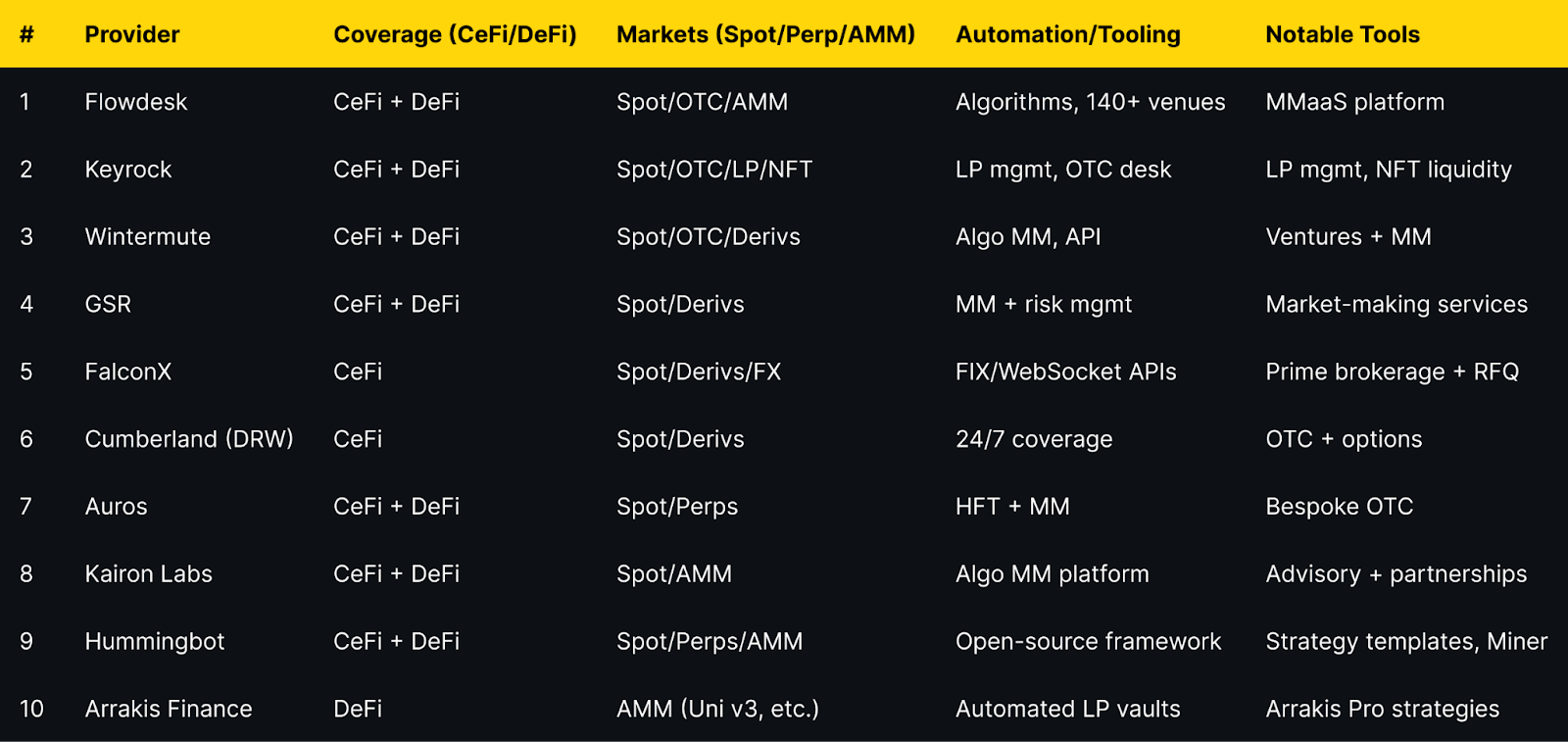
Evidence for venue coverage and capabilities appears in provider sections below.
Top 10 Crypto Liquidity Management & Market-Making Tools in November 2025
1. Flowdesk — Best for compliance-first MMaaS at global scale
Why Use It. Flowdesk runs a compliance-first market-making and OTC platform with proprietary execution algos and integrations across 140+ centralized and decentralized exchanges, suitable for token issuers that need unified coverage and reporting. (flowdesk.co)
Best For. Token issuers; exchanges; DAOs with multi-venue liquidity needs; teams prioritizing compliance.
Notable Features. Low-latency infrastructure; MMaaS with 24/7 teams; 140+ venue connectivity; internal policies & compliance center. (flowdesk.co)
Consider If. You want documented models (retainer vs loan/call) and clear KPIs before engagement. (flowdesk.co)
Fees Notes. Custom; contract-based; network/exchange fees apply.
Regions. Global; subject to local licensing and restrictions (France DASP registration referenced on site). (flowdesk.co)
Alternatives. Keyrock; GSR.

2. Keyrock — Best for full-stack liquidity (MM, OTC, LP, NFTs)
Why Use It. Keyrock delivers market making, OTC trading, treasury solutions, and liquidity pool management for token issuers and venues; it also offers NFT liquidity and publishes security awareness and terms. (Keyrock)
Best For. Issuers needing both CeFi and DeFi coverage; platforms adding NFT or LP liquidity.
Notable Features. Liquidity pool management; OTC/options; NFT liquidity; research/insights. (Keyrock)
Consider If. You want a single counterparty handling MM + LP mgmt with documented terms. (Keyrock)
Fees Notes. Custom; scope-based; network/exchange fees may apply.
Regions. Global; services subject to applicable laws and platform eligibility.
Alternatives. Flowdesk; Wintermute.

3. Wintermute — Best for algorithmic crypto liquidity at scale
Why Use It. Wintermute is a leading algorithmic trading firm and liquidity partner that supports efficient markets across centralized and decentralized venues, with a broader ventures arm for strategic projects. (wintermute.com)
Best For. Larger token issuers and institutions that want deep, programmatic liquidity and breadth of venues.
Notable Features. Algorithmic MM; OTC; venture support; expanding US presence. (fnlondon.com)
Consider If. You need institutional processes and policy engagement in the US market. (fnlondon.com)
Fees Notes. Custom; inventory/retainer structures typical.
Regions. Global.
Alternatives. GSR; FalconX.

4. GSR — Best for crypto liquidity + risk management depth
Why Use It. GSR offers market-making and risk management across spot and derivatives, working with exchanges, token issuers, and institutions; it publishes regular research and insights. (gsr.io)
Best For. Issuers seeking experienced MM with derivatives coverage and institutional process.
Notable Features. Trading + market making services; exchange connectivity; research hub. (gsr.io)
Consider If. You need structured reporting and risk frameworks across venues.
Fees Notes. Custom; scope-based; exchange/network fees apply.
Regions. Global.
Alternatives. Wintermute; Flowdesk.
5. FalconX — Best prime brokerage + deep crypto liquidity access
Why Use It. FalconX is a prime broker with $2T+ executed and access to 400+ tokens, offering unified spot/derivs/FX execution, OTC, and APIs (WebSocket/FIX/REST). (falconx.io)
Best For. Institutions wanting a single counterparty with RFQ, streaming, and FIX integration.
Notable Features. Deep liquidity pool; algorithmic/TWAP tools; ETF issuer liquidity support; Talos integrations. (falconx.io)
Consider If. You want prime services plus execution algos rather than a pure MM retainer.
Fees Notes. Custom; execution- and volume-based; venue/network fees apply.
Regions. Global (token availability may vary). (falconx.io)
Alternatives. Cumberland; GSR.
6. Cumberland (DRW) — Best for institutional OTC and options
Why Use It. A DRW subsidiary active since 2014 in digital assets, Cumberland provides 24/7 institutional liquidity across spot, listed derivatives, bilateral options, and NDFs, with relationship coverage. (cumberland.io)
Best For. Institutions needing OTC block liquidity and derivatives structures.
Notable Features. OTC/RFQ; BTC/ETH options; futures basis; DRW backing. (cumberland.io)
Consider If. You need large, bespoke trades and derivatives hedging under institutional processes.
Fees Notes. Custom; RFQ spreads/commissions; venue/network fees apply.
Regions. Global, subject to applicable regulations.
Alternatives. FalconX; Wintermute.
7. Auros — Best for HFT-driven market-making with bespoke design
Why Use It. Auros combines high-frequency trading and strategic market making across CeFi and DeFi with bespoke OTC and transparency-oriented reporting for token stability. (Auros)
Best For. Projects seeking a partner for token launch support and stability across venues.
Notable Features. HFT + MM stack; CeFi/DeFi coverage; insights & reporting. (Auros)
Consider If. You want tailored strategies and comms during volatility.
Fees Notes. Custom; scope-based; network/venue fees apply.
Regions. Global.
Alternatives. Kairon Labs; GSR.
8. Kairon Labs — Best issuer-focused market-making + advisory
Why Use It. Kairon Labs provides algorithmic market making, liquidity provision, partnerships, and advisory for issuers, with educational content on MM models (designated vs principal). (kaironlabs.com)
Best For. Small–mid cap issuers needing hands-on guidance plus execution.
Notable Features. Issuer-centric services; partnerships support; model education. (kaironlabs.com)
Consider If. You want advisory plus MM under one roof.
Fees Notes. Custom; scope-based; exchange/network fees apply.
Regions. Global.
Alternatives. Auros; Flowdesk.
9. Hummingbot — Best open-source framework for DIY market making
Why Use It. Hummingbot is an open-source Python framework to run automated strategies on any CEX/DEX, with built-in templates for pure market making and perpetual MM and extensive docs. (hummingbot.org)
Best For. Developers, quant hobbyists, and small desks wanting DIY automation.
Notable Features. Strategy library; Docker/API quickstarts; Miner rewards marketplace. (hummingbot.org)
Consider If. You accept self-hosting and operational overhead instead of a service contract.
Fees Notes. Software is free; trading/withdrawal/network fees still apply.
Regions. Global (open-source).
Alternatives. Arrakis (for LP vaults); Keyrock (for managed LP).
10. Arrakis Finance — Best for automated onchain LP management (Uni v3 & more)
Why Use It. Arrakis provides automated LP vaults and Arrakis Pro strategies for token issuers to manage concentrated liquidity with rebalancing and inventory targeting. (arrakis.finance)
Best For. Projects prioritizing DeFi AMM depth and capital efficiency on Uniswap v3-style DEXs.
Notable Features. Ongoing inventory management; automated rebalancing; issuer-specific vault programs. (arrakis.finance)
Consider If. You need onchain, non-custodial liquidity programs over CeFi MM retainers.
Fees Notes. Protocol/vault fees; gas costs on supported chains.
Regions. Global (onchain).
Alternatives. Hummingbot (DIY); GSR (CeFi/MM).
Decision Guide: Best By Use Case
- Regulated, compliance-first MMaaS: Flowdesk. (flowdesk.co)
- One-stop liquidity incl. NFTs & LP mgmt: Keyrock. (Keyrock)
- Algorithmic MM at institutional scale: Wintermute or GSR. (wintermute.com)
- Prime brokerage + FIX/WebSocket execution: FalconX. (falconx.io)
- OTC blocks + options structures: Cumberland (DRW). (cumberland.io)
- Launch support with HFT expertise: Auros. (Auros)
- Issuer-centric MM + advisory: Kairon Labs. (kaironlabs.com)
- DIY automation (open-source): Hummingbot. (hummingbot.org)
- Onchain concentrated liquidity programs: Arrakis Finance. (arrakis.finance)
How to Choose the Right Crypto Liquidity Management & Market-Making Tool (Checklist)
- Region eligibility & licensing: Confirm provider registrations and legal terms in your jurisdictions.
- Venue coverage: CeFi exchanges, perps venues, and DeFi AMMs you actually need.
- Inventory model: Retainer vs. inventory loan/call; required collateral and risks. (flowdesk.co)
- Execution stack: APIs (FIX/WebSocket/REST), algos, latency, and monitoring. (falconx.io)
- Onchain LP management: If DeFi-first, evaluate vault design, rebalancing, and transparency. (arrakis.finance)
- Reporting & SLAs: Daily/weekly liquidity KPIs, spread targets, uptime, incident process.
- Security & compliance: Insider-trading controls, conflict-of-interest policies, audits/policies page. (flowdesk.co)
- Costs & fees: Understand spread capture, performance fees, platform fees, and gas.
- Offboarding plan: Access to accounts, revocation of keys, vault migrations, and documentation.
Red flags: No written terms, vague reporting, or inability to name supported venues.
Use Token Metrics With Any Crypto Liquidity Provider
- AI Ratings to screen assets by quality and momentum before listings.

- Narrative Detection to catch early theme shifts that can impact liquidity.
- Portfolio Optimization to size inventory across chains and LPs.
- Alerts & Signals to time entries/exits and rebalance LP ranges.
Workflow: Research in Token Metrics → Select provider → Execute on-chain/CeFi → Monitor with alerts.
Start free trial to screen assets and time entries with AI.

Security & Compliance Tips
- Prefer partners that publish policies/compliance pages and name registrations. (flowdesk.co)
- Segregate exchange accounts and use least-privilege API keys; rotate regularly.
- For DeFi vaults, verify non-custodial design, fee schedules, and admin controls. (arrakis.finance)
- Confirm reporting cadence (inventory, spreads, volume, venue list).
- Use official domains and channels to avoid impersonation. (Keyrock)
- Understand engagement models (retainer vs loan/call) and associated risks. (flowdesk.co)
This article is for research/education, not financial advice.
Beginner Mistakes to Avoid
- Signing without clear KPIs (spread, depth, venue list).
- Ignoring region restrictions or licensing.
- Overlooking DeFi vault mechanics (rebalance rules, fees, inventories). (arrakis.finance)
- Mixing treasury and MM wallets without operational controls.
- Choosing CeFi-only when you need AMM depth (or vice versa).
- Underestimating implementation: APIs, custody, exchange listings, oracle feeds.
How We Picked (Methodology & Scoring)
We scored each provider using the following weights:
- Liquidity — 30% (depth, spreads, execution venues)
- Security — 25% (controls, disclosures, compliance posture)
- Coverage — 15% (CeFi/DeFi, spot/derivs, chain support)
- Costs — 15% (fee clarity, model fit, onchain costs)
- UX — 10% (integration, tooling, reporting)
- Support — 5% (24/7 coverage, responsiveness)
Data sources: official product, docs, pricing/terms, security/policies, and status pages; reputable market datasets used only to cross-check scale and venues. Last updated November 2025.
FAQs
What are liquidity management and market-making tools?
Software platforms and service providers that supply bids/asks, balance inventory, and manage onchain liquidity so markets remain liquid with tighter spreads and lower slippage (CeFi and DeFi).
Are managed market makers or DIY bots safer?
Managed providers handle execution, risk, and reporting under contracts; DIY bots like Hummingbot provide control but require operational expertise and monitoring. Choose based on team capacity and risk tolerance. (hummingbot.org)
How do providers charge?
Common models include retainers, inventory loan/call structures, execution fees/spreads, and protocol/vault fees on DeFi. Clarify model, caps, and KPI targets before engagement. (flowdesk.co)
Can I combine CeFi MM with DeFi vaults?
Yes. Many issuers use a CeFi MM for order books plus an onchain LP manager (e.g., Arrakis) for AMM depth, with shared reporting and risk limits. (arrakis.finance)
Do these tools work in the US/EU/APAC?
Most providers are global but subject to local regulations, listings, and counterparty restrictions. Check each provider’s terms/compliance pages and confirm venue eligibility. (flowdesk.co)
Conclusion + Related Reads
If you want compliance-centric, multi-venue coverage, start with Flowdesk or Keyrock. For institutional scale, add Wintermute or GSR. If you need prime services and execution, consider FalconX or Cumberland. For DIY or onchain-first, evaluate Hummingbot and Arrakis.
Related Reads (Token Metrics):
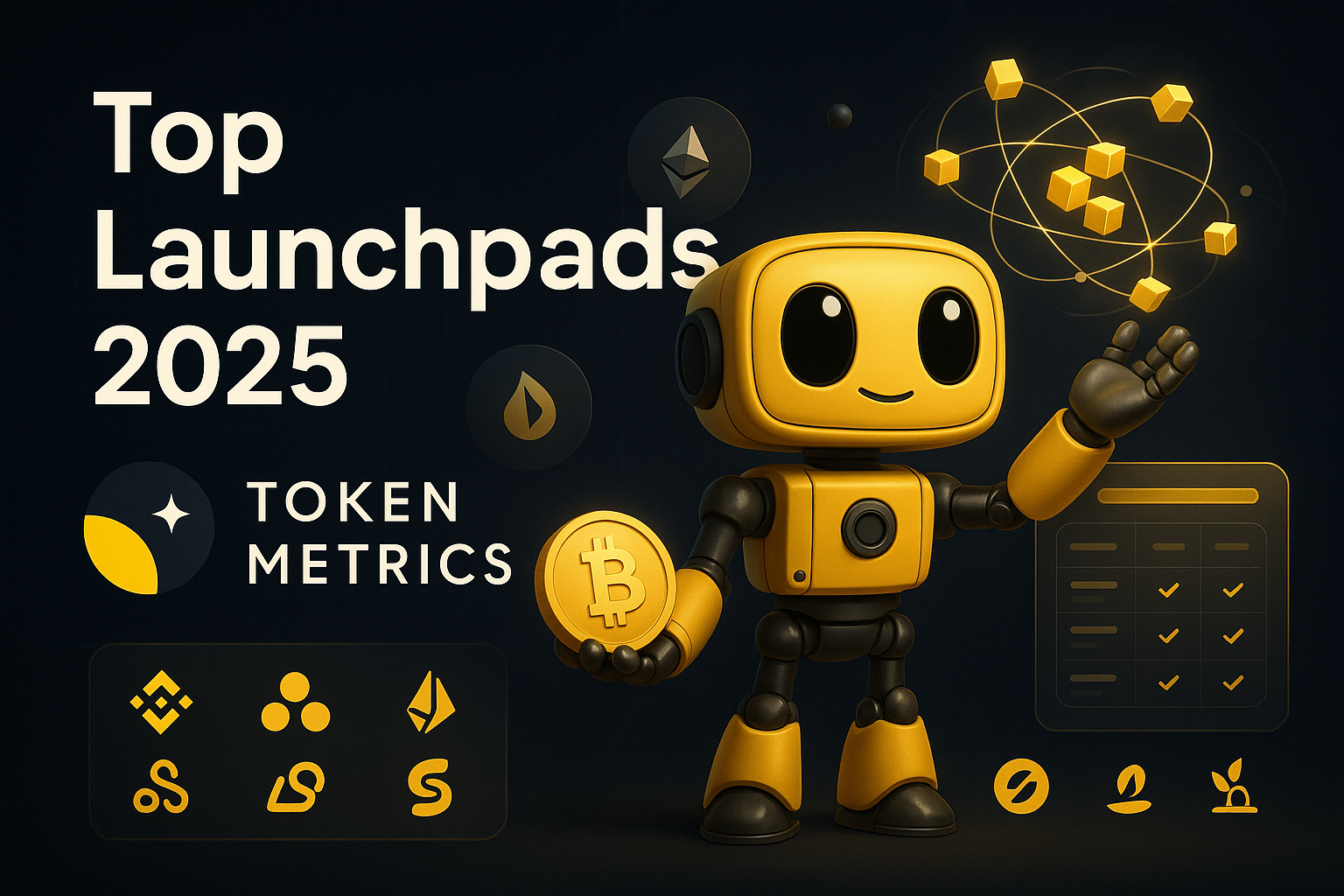
Best Crypto Launchpads & IDO/IEO Platforms (2025)
%201.svg)
%201.svg)
Who this guide is for. Crypto investors comparing best crypto launchpads 2025 to access early token sales with clearer rules, costs, and eligibility.
Top three picks.
- Binance Launchpad — scale + liquidity, clear subscription/holding models. (Binance Launchpad | Binance)
- OKX Jumpstart — simple mining/sale formats, frequent events. (OKX)
- Bybit Launchpad — accessible formats across CEX + Web3 IDO. (bybit.com)
One key caveat. Availability varies by jurisdiction (many CEX launchpads restrict U.S. users and require KYC). Always check your platform’s official eligibility and KYC pages. (Binance)
Introduction: Why Crypto Launchpads & IDO/IEO Platforms Matter in November 2025
Definition (snippet-ready): A crypto launchpad is a platform that hosts early token distribution events (IDO/IEO) with defined participation rules, allocations, and settlement.
In 2025, primary-market access has consolidated around large exchanges and a handful of battle-tested decentralized platforms. For investors, best crypto launchpads 2025 decisions hinge on liquidity, security/compliance, costs, and eligibility. Centralized exchange (CEX) launchpads (e.g., Binance, OKX, Bybit) emphasize KYC and region filters, while decentralized launchpads (e.g., Polkastarter, DAO Maker) lean on wallet-based participation and project curation. We scored providers using transparent weights, verified details only from official pages, and noted regional restrictions where platforms disclose them. Freshness: Updated November 2025.
How We Picked (Methodology & Scoring)
We shortlisted ~20 credible platforms, then selected TOP_N = 10 based on official evidence (docs/help/pricing/status/security pages). Third-party data was used only for cross-checks, not cited.
Scoring Weights (sum = 100):
- Crypto Liquidity — 30% (exchange depth, historical sale demand, listing path)
- Security — 25% (KYC/eligibility controls, disclosures, operational maturity)
- Coverage — 15% (event frequency, multichain reach)
- Costs — 15% (explicit sale/processing fees when stated; otherwise “varies; network fees apply”)
- UX — 10% (clarity of rules, access flow)
- Support — 5% (help center clarity, announcements cadence)
Data sources: Official product, help, terms, and announcement pages; platform status/audit pages where available. Last updated: November 2025.
Best Crypto Launchpads & IDO/IEO Platforms in November 2025 (Comparison Table)
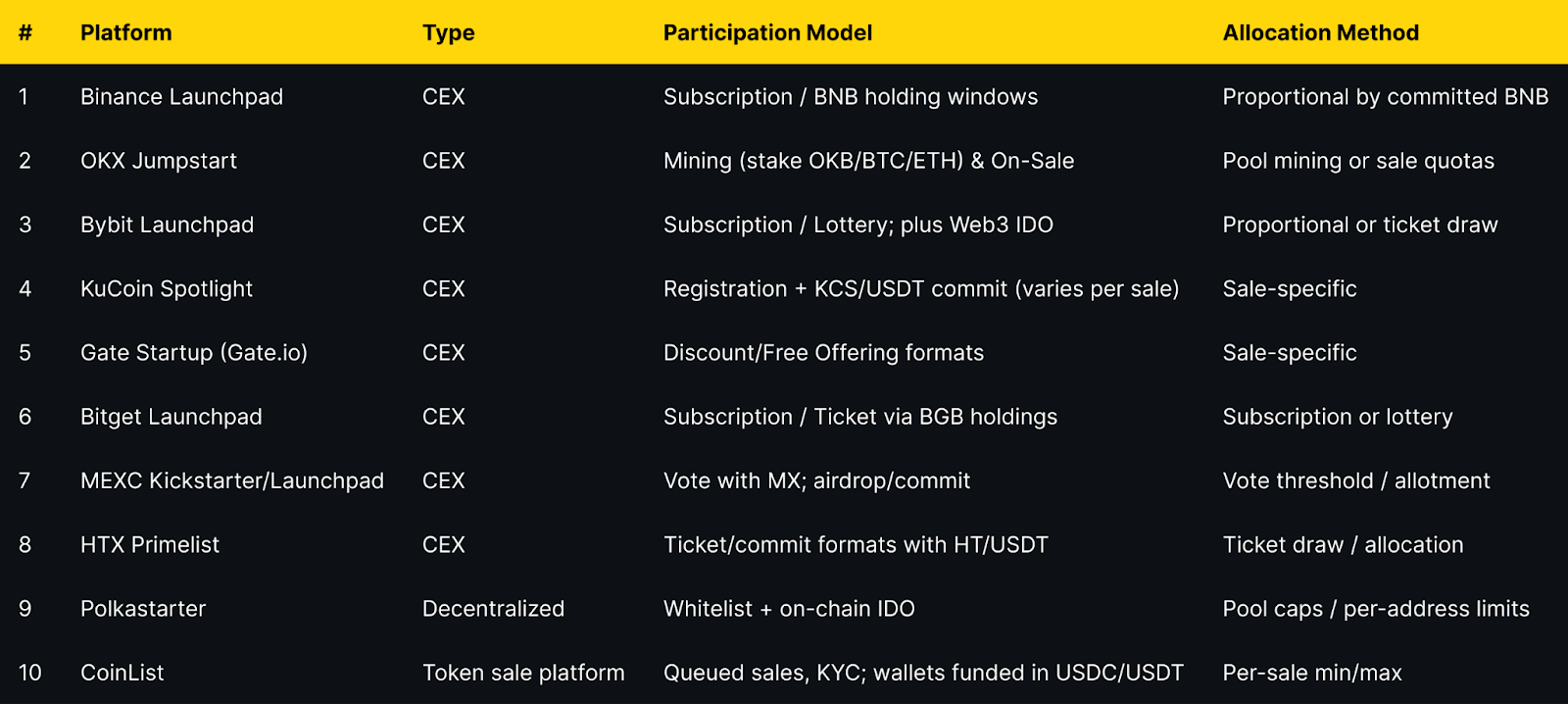
* Always confirm current eligibility on the platform’s official Terms/Help pages before participating.
** Some decentralized pools may require external KYC/allowlists set by the project.
Top 10 Crypto Launchpads & IDO/IEO Platforms in November 2025
1. Binance Launchpad — Best for scale and liquidity
Why Use It. Binance Launchpad runs subscription-style sales that typically require BNB holdings across a snapshot window, then proportional allocation by committed BNB. The process is well documented and integrated with Binance listings, giving post-sale liquidity depth. (Binance Launchpad | Binance)
Best For. Allocation hunters, liquidity-first traders, portfolio builders seeking large-venue listings.
Notable Features. Subscription model; BNB commitment windows; integrated post-listing ecosystem; robust help center. (Binance)
Consider If. Not available in prohibited jurisdictions; KYC required. (Binance)
Fees Notes. Varies; trading/network fees apply.
Regions. Global, with restricted countries noted in Terms. (Binance)
Alternatives. OKX Jumpstart, Bybit Launchpad.
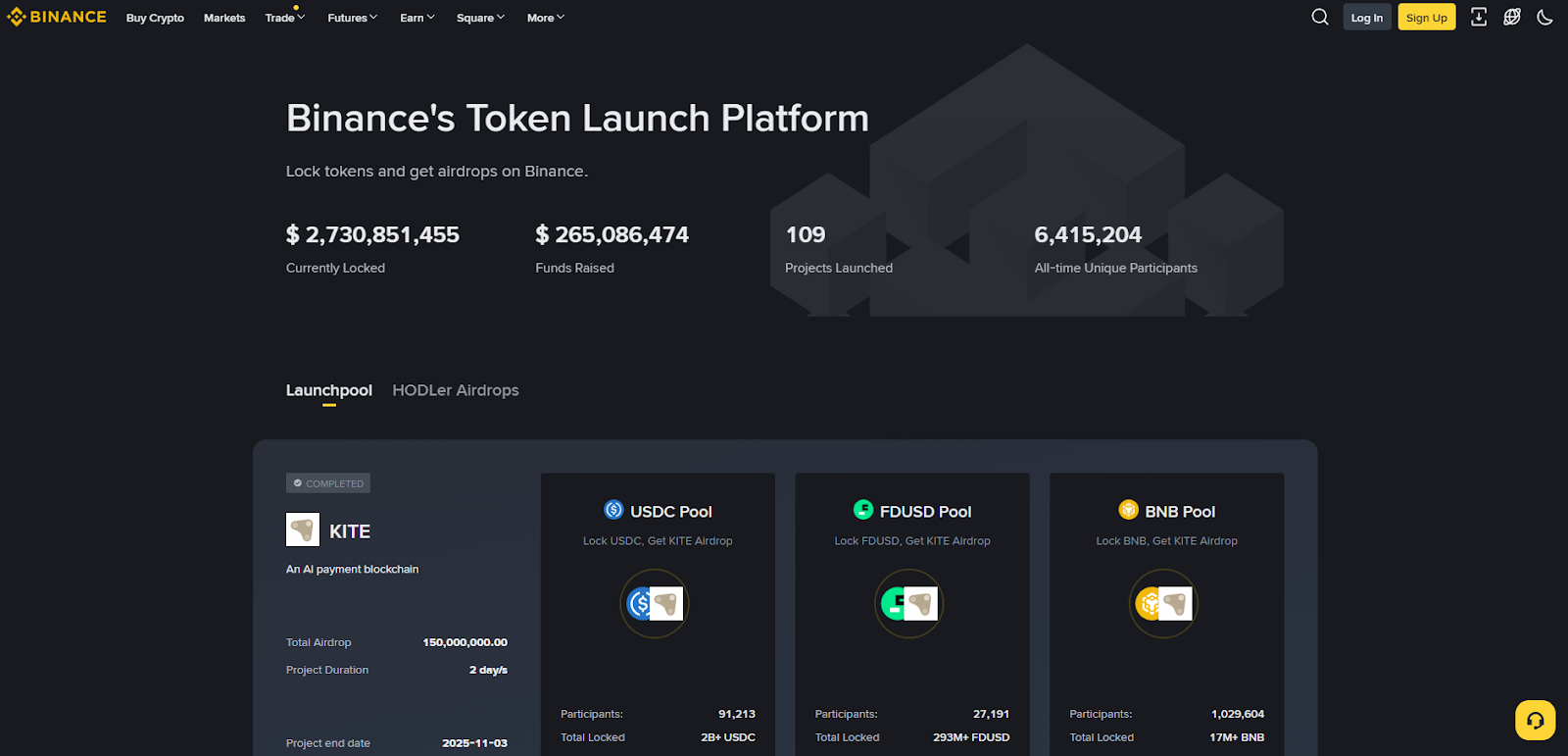
2. OKX Jumpstart — Best for simple mining + sale formats
Why Use It. Jumpstart offers Mining events where users stake assets (e.g., OKB, BTC, ETH) to earn new tokens, alongside occasional On-Sale formats. Participation rules are clearly posted per event. (OKX)
Best For. Long-only users holding OKB/BTC/ETH, set-and-forget miners, diversified hunters of frequent drops.
Notable Features. Mining & sale dual formats; event pages with tokenomics; frequent announcements. (OKX)
Consider If. Jurisdiction limits apply; verify your eligibility. (OKX)
Fees Notes. Varies; network fees apply.
Regions. Global with restrictions per OKX policies.
Alternatives. Binance Launchpad, Gate Startup.
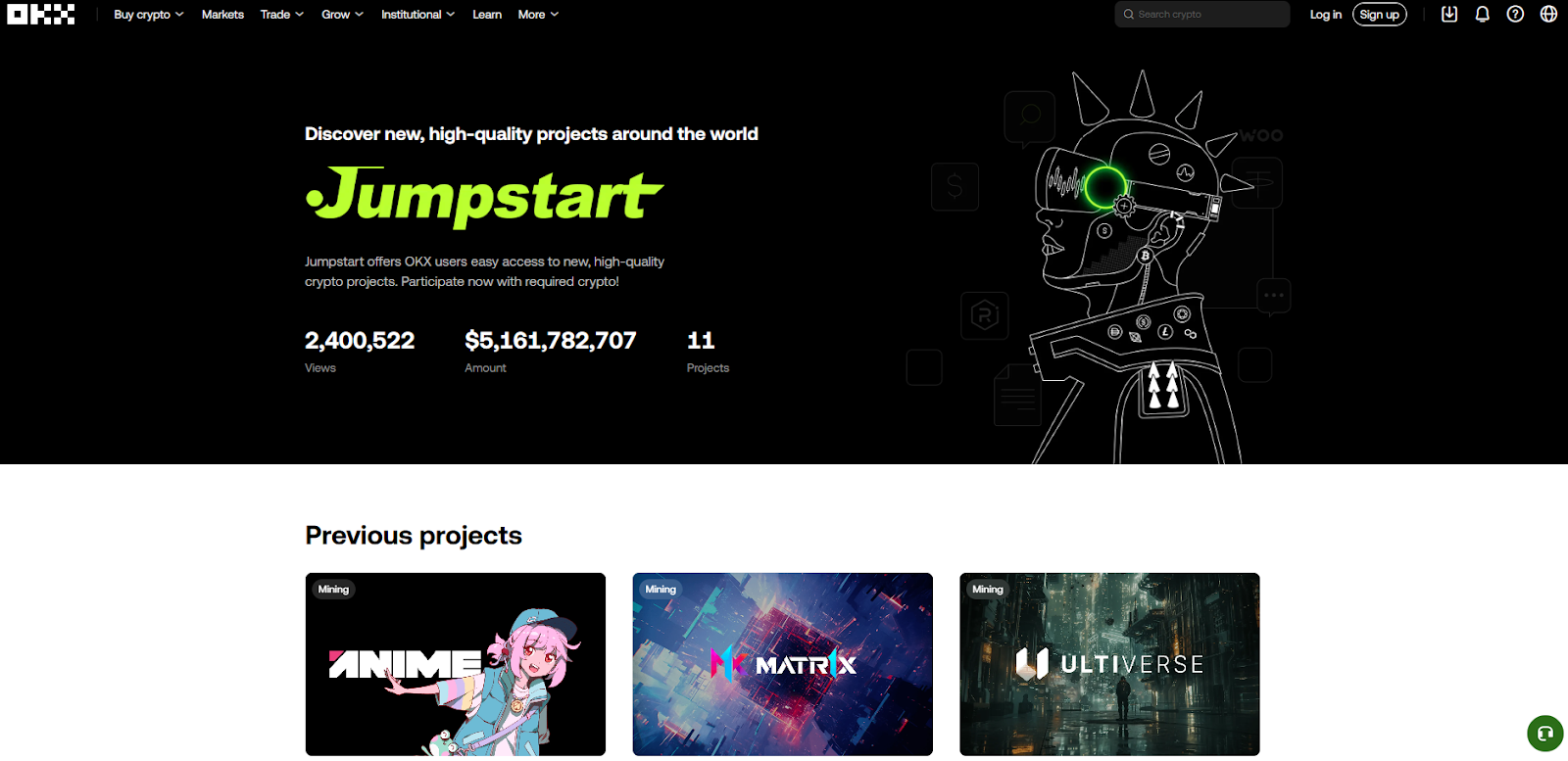
3. Bybit Launchpad — Best CEX + Web3 coverage
Why Use It. Bybit runs subscription/lottery sales on the exchange and also operates a Web3 IDO platform for wallet-based participation. Clear KYC tiers and frequent help-center updates support new users. (bybit.com)
Best For. Users who want both exchange launchpad and Web3 IDO in one brand, ticket/lottery mechanics.
Notable Features. Subscription and lottery formats; Web3 IDO portal; detailed KYC guidance. (bybit.com)
Consider If. Not available in excluded jurisdictions (e.g., U.S.). (bybit.com)
Fees Notes. Varies; network fees apply.
Regions. Global (excluded jurisdictions listed by Bybit). (bybit.com)
Alternatives. Binance Launchpad, Bitget Launchpad.
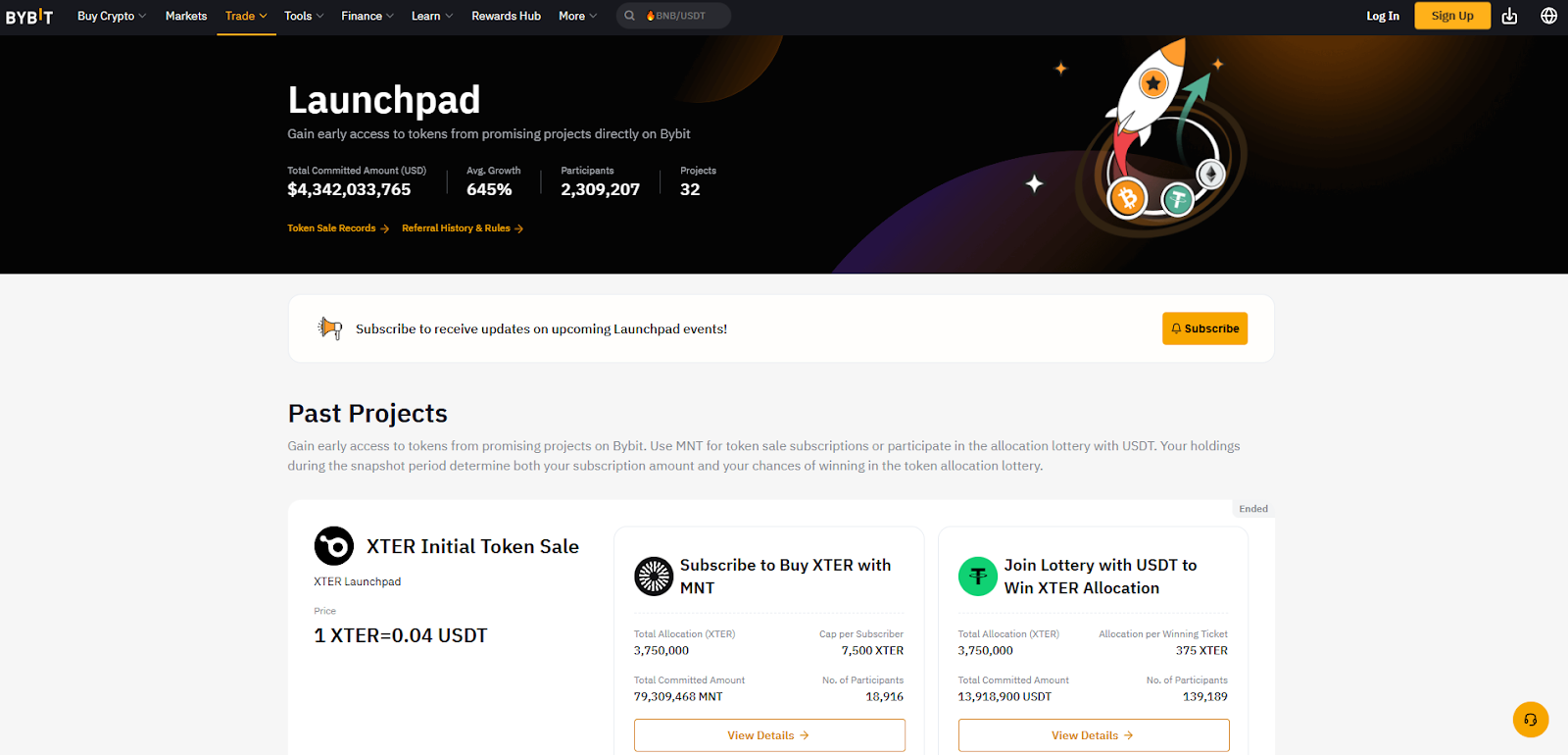
4. KuCoin Spotlight — Best for altcoin discovery on a major exchange
Why Use It. Spotlight aggregates new listings and has hosted high-profile events. Participation generally requires KYC and following sale-specific rules posted in help/announcement pages. (KuCoin)
Best For. Altcoin-oriented users who want curated sales and subsequent exchange liquidity.
Notable Features. Dedicated Spotlight center; sale how-to guides; history of ended sales. (KuCoin)
Consider If. U.S. users are restricted per KuCoin Terms. (KuCoin)
Fees Notes. Varies; network fees apply.
Regions. Global (U.S. and other locations restricted). (KuCoin)
Alternatives. Gate Startup, MEXC Kickstarter.
5. Gate Startup (Gate.io) — Best for frequent offerings and varied formats
Why Use It. Gate’s Startup page offers discount and free-offering formats, with active cadence and explicit instructions in announcements and help articles. KYC is required for participation. (Gate.com)
Best For. Deal hunters, high-frequency participants, multi-format collectors.
Notable Features. Discount and free-offering modes; constant announcements; centralized hub. (Gate.com)
Consider If. Make sure you’ve completed Gate KYC before events. (Gate.com)
Fees Notes. Varies; network fees apply.
Regions. Global (subject to KYC and eligibility).
Alternatives. OKX Jumpstart, MEXC Kickstarter.
6. Bitget Launchpad — Best for BGB-based subscription or ticket access
Why Use It. Bitget runs subscription and ticket models, often tied to BGB holdings/trading activity. Official FAQ and blog posts detail eligibility and formats. (bitget.com)
Best For. Users already in the Bitget ecosystem; lottery-style allocation seekers.
Notable Features. BGB-linked ticketing; subscription flows; event records page. (bitget.com)
Consider If. Region limits apply and formats can vary by event.
Fees Notes. Varies; network fees apply.
Regions. Global with restrictions.
Alternatives. Bybit Launchpad, HTX Primelist.
7. MEXC Kickstarter / Launchpad — Best for vote-to-airdrop mechanics
Why Use It. Kickstarter lets MX holders vote to support pre-launch projects and receive airdrops when thresholds are met; official FAQs outline steps and eligibility. (MEXC)
Best For. Airdrop hunters, MX token holders, event-driven users.
Notable Features. Vote-to-airdrop; quick-commit across events; MX minimums. (MEXC)
Consider If. Rewards, formats, and eligibility can change per event—read each page.
Fees Notes. Varies; network fees apply.
Regions. Global with restrictions.
Alternatives. Gate Startup, Bitget Launchpad.
8. HTX Primelist — Best for ticket/commit sale mechanics
Why Use It. Primelist runs ticket/commit structures where users may lock HT/USDT or complete tasks to obtain tickets; official announcements describe cadence and rules. (htx.com)
Best For. Users comfortable with ticket allocations and exchange-based listings.
Notable Features. Ticket draws; commitment options; frequent listing promos. (htx.com)
Consider If. Check jurisdiction limits and sale-specific rules each time.
Fees Notes. Varies; network fees apply.
Regions. Global with restrictions.
Alternatives. Bitget Launchpad, Bybit Launchpad.
9. Polkastarter — Best decentralized IDO for whitelists and on-chain caps
Why Use It. Polkastarter hosts curated on-chain IDOs with per-address caps and allowlists, giving transparent pool limits and wallet-based participation. Project pages and a launch portal outline the process. (polkastarter.com)
Best For. Users preferring self-custody, on-chain settlement, and project allowlists.
Notable Features. On-chain pools; whitelist workflows; project directories. (polkastarter.com)
Consider If. Some projects impose geofences/KYC—always read pool terms.
Fees Notes. Network gas; project-level terms.
Regions. Global; project-dependent restrictions may apply.
Alternatives. DAO Maker, CoinList.
10. CoinList — Best for fully KYC’d token sales and wallet funding
Why Use It. CoinList runs queued token sales with per-sale minimums/maximums and strict KYC. Help articles detail wallet funding in USDC/USDT and purchase flows. (CoinList)
Best For. Users who prefer structured, compliance-forward public sales with clear limits.
Notable Features. Queue systems; per-sale caps; explicit instructions; wallet funding guides. (CoinList)
Consider If. Eligibility varies by sale; expect KYC and sometimes region-specific exclusions.
Fees Notes. Stated per sale; network fees apply.
Regions. Global (U.S. participation depends on each sale’s terms).
Alternatives. Polkastarter, Binance Launchpad.
Decision Guide: Best By Use Case
- Largest venue + liquidity: Binance Launchpad. (Binance Launchpad | Binance)
- Stake-to-earn + sales cadence: OKX Jumpstart. (OKX)
- Exchange + Web3 IDO in one brand: Bybit Launchpad / Bybit Web3 IDO. (bybit.com)
- Altcoin discovery, historical sale stream: KuCoin Spotlight. (KuCoin)
- Frequent discount/free offerings: Gate Startup. (Gate.com)
- Lottery/ticket mechanics with native token: Bitget Launchpad. (bitget.com)
- Vote-to-airdrop model: MEXC Kickstarter. (MEXC)
- Ticket/commit structure alternative: HTX Primelist. (htx.com)
- Decentralized, wallet-based IDO: Polkastarter. (polkastarter.com)
- KYC-heavy, queued sales: CoinList. (CoinList)
How to Choose the Right Launchpads & IDO/IEO Platforms (Checklist)
- Confirm region eligibility and KYC requirements on official pages. (Binance)
- Match participation model to your balance (subscription, tickets, staking, whitelist).
- Review allocation math (proportional vs. lottery vs. per-address caps).
- Verify fees and settlement (sale fees if stated; otherwise network gas).
- Assess liquidity path post-sale (likely listing venue/pairs).
- Read project pages/announcements for rules and tokenomics. (OKX)
- Confirm wallet readiness (CEX spot wallet vs. Web3 wallet).
- Check support/help centers for timelines and dispute processes. (bybit.com)
- Look for status/security disclosures when available.
- Red flag: Guaranteed returns, unclear token distribution, or missing official docs.
Use Token Metrics With Any Crypto Launchpads & IDO/IEO Platforms
- AI Ratings to screen assets for quality and momentum before committing.
- Narrative Detection to spot emerging themes early.

- Portfolio Optimization to size positions across chains and venues.
- Alerts & Signals to time unlocks, listings, and trend shifts.
Workflow: Research with TM → Choose platform → Execute sale participation → Monitor with alerts.
Start free trial to screen assets and time entries with AI.

Security & Compliance Tips
- Use official URLs only; watch for spoofed domains.
- Complete KYC where required; never share documents outside official flows. (bybit.com)
- For decentralized sales, verify contract addresses and pool caps on official pages. (polkastarter.com)
- Understand allocation rules (subscription math, lottery odds, staking snapshots). (Binance)
- Track vesting/claim portals via official announcements. (OKX)
- Avoid over-approving Web3 wallets; limit approvals and revoke after use.
- Maintain 2FA and withdrawal allowlists on CEX accounts.
- {This article is for research/education, not financial advice.}
Beginner Mistakes to Avoid
- Joining from a restricted jurisdiction and losing access later. (bybit.com)
- Ignoring sale-specific rules (snapshots, minimums, per-sale caps). (CoinList)
- Using the wrong wallet type for Web3 IDO vs. CEX subscription. (bybit.com)
- Overlooking vesting/claim deadlines and token distribution mechanics. (OKX)
- Falling for unofficial links or phishing around high-demand sales.
- Committing more than you can afford under volatile market conditions.
How We Picked (Methodology & Scoring)
We evaluated ~20 providers (including Seedify, TrustPad, BSCPad, PinkSale, BullPerks, Enjinstarter, Poolz, WeStarter, GameFi, ApeTerminal, and Republic Crypto) for liquidity (30), security (25), coverage (15), costs (15), UX (10), support (5) using only official pages for claims. We excluded defunct/region-ineligible platforms for Global readers or those lacking current official documentation. Last updated November 2025.
FAQs
What is a crypto launchpad?
A platform that hosts early token distributions (IDO/IEO) with rules for eligibility, allocation, and settlement, either on an exchange or on-chain.
Are launchpads safe?
Safety depends on the platform and the project. Prefer venues with clear KYC/eligibility, transparent rules, and official documentation, and use strong account security. (Binance)
What fees should I expect?
Some platforms state sale/processing terms on event pages; otherwise expect network gas and standard trading fees after listing. Always read each sale’s official page.
Can U.S. users participate?
Many CEX launchpads restrict U.S. users per their Terms. Check platform eligibility before committing. (Binance)
Do I need KYC?
Most CEX launchpads require KYC. Decentralized IDOs may be wallet-only but can still impose allowlists or geofences per project. (bybit.com)
How do allocation methods differ?
Common approaches include proportional subscription, lottery/tickets, staking/mining, and whitelist caps for on-chain pools. (Binance)
Conclusion + Related Reads
If you want the broadest liquidity and simple participation, start with Binance Launchpad or OKX Jumpstart. For CEX + Web3 flexibility, Bybit stands out. Prefer self-custody? Explore Polkastarter and read each project’s terms carefully. Pair your launchpad activity with Token Metrics research, alerts, and portfolio tools to manage risk.
Related Reads:

Best Cross-Chain Bridges for Crypto Traders (2025)
%201.svg)
%201.svg)
Who this guide is for: Traders, DeFi users, and multichain portfolio managers seeking secure, cost-effective ways to move assets across blockchains.
Top three picks:
- Stargate Finance — deepest liquidity for stablecoin transfers across major EVM chains and non-EVM networks.
- Synapse Protocol — fastest routes for traders needing sub-5-minute settlements on 20+ chains.
- Across Protocol — lowest slippage and optimistic bridging for arbitrageurs and high-frequency movers.
Key caveat: Bridge fees vary by route, liquidity depth, and network congestion; always compare quotes and verify destination addresses before confirming transfers.
Introduction: Why Cross-Chain Bridges Matter in 2025
Cross-chain bridges are infrastructure protocols that enable seamless asset transfers between blockchains, solving fragmented liquidity and allowing traders to access opportunities across ecosystems without holding native tokens on every chain. In 2025, with over 100 active Layer 1 and Layer 2 networks, best cross-chain bridges for traders deliver speed, security, and capital efficiency—critical for arbitrage, yield farming, and portfolio rebalancing. This guide evaluates the top 10 cross-chain bridges based on liquidity depth, security architecture, chain coverage, fee transparency, and user experience, helping you select the right solution for your trading strategy.
How We Picked (Methodology & Scoring)
We evaluated 20+ cross-chain bridges using six weighted criteria:
- Liquidity & Volume (30%) — Daily transfer volume, pool depth, and slippage on major routes
- Security Architecture (25%) — Validator model, audit history, exploit record, bug bounties
- Chain Coverage (15%) — Number of supported networks (EVM, non-EVM, L2s)
- Costs & Fees (15%) — Bridge fees, gas optimization, hidden slippage
- User Experience (10%) — Interface clarity, transaction speed, wallet integrations
- Support & Documentation (5%) — Docs quality, status pages, support channels
Data sources: Official protocol documentation, pricing pages, security audit repositories, and status dashboards. Third-party volume data from CoinGecko and DefiLlama used for cross-checks only.
Last updated: November 2025
Best Cross-Chain Bridges in 2025 (Comparison Table)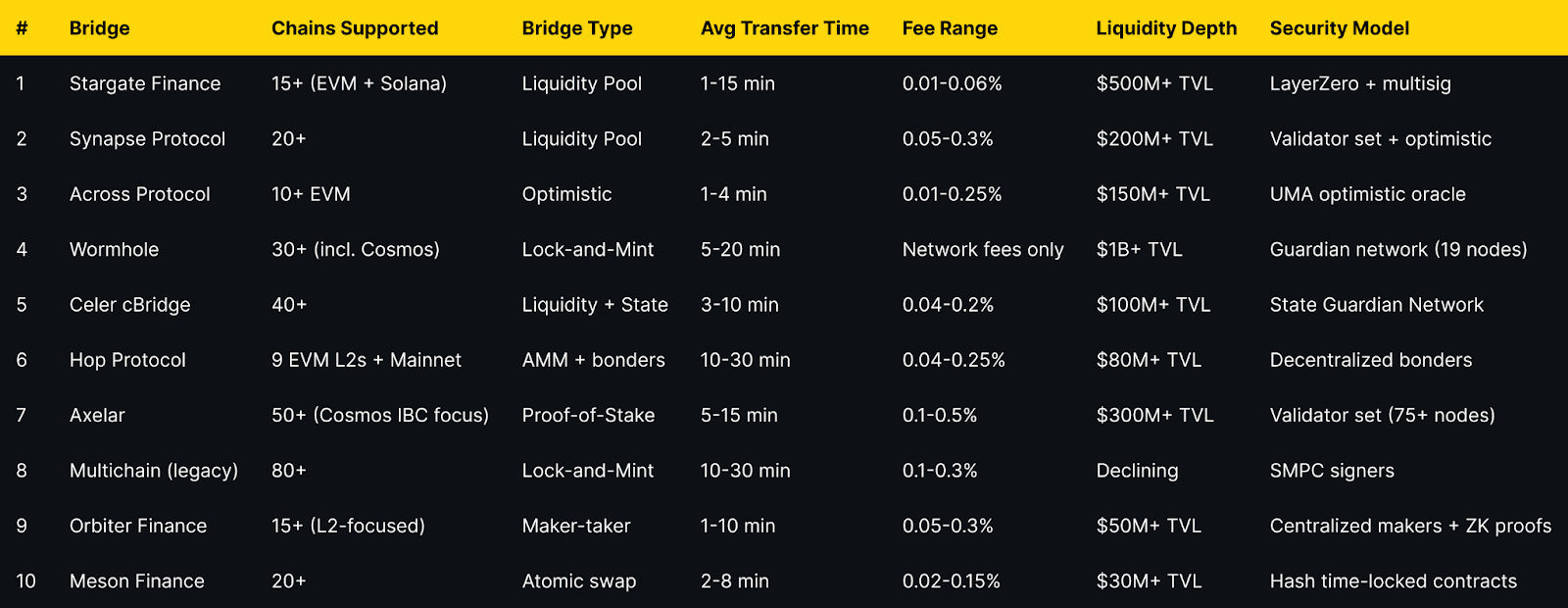
Top 10 Cross-Chain Bridges in 2025
1. Stargate Finance — Best for Stablecoin Transfers
Why Use It: Stargate leverages LayerZero's messaging protocol to offer unified liquidity pools across 15+ chains, ensuring minimal slippage for USDC, USDT, and DAI transfers. Traders benefit from instant guaranteed finality and native asset transfers without wrapped tokens, making it ideal for large stablecoin movements between Ethereum, Arbitrum, Optimism, Polygon, BNB Chain, Avalanche, and Solana.
Best For: DeFi yield farmers, arbitrageurs moving stablecoins, traders rebalancing across chains, institutional desks.
Notable Features:
- Unified liquidity pools eliminate fragmented routes
- Delta algorithm prevents pool depletion and maintains balance
- Native USDC/USDT support on major chains
- Audited by Quantstamp and Zellic with $25M bug bounty
Consider If: You need to bridge non-stablecoin assets frequently (limited ERC-20 coverage) or require sub-1-minute finality (average 1-15 min).
Alternatives: Synapse Protocol, Across Protocol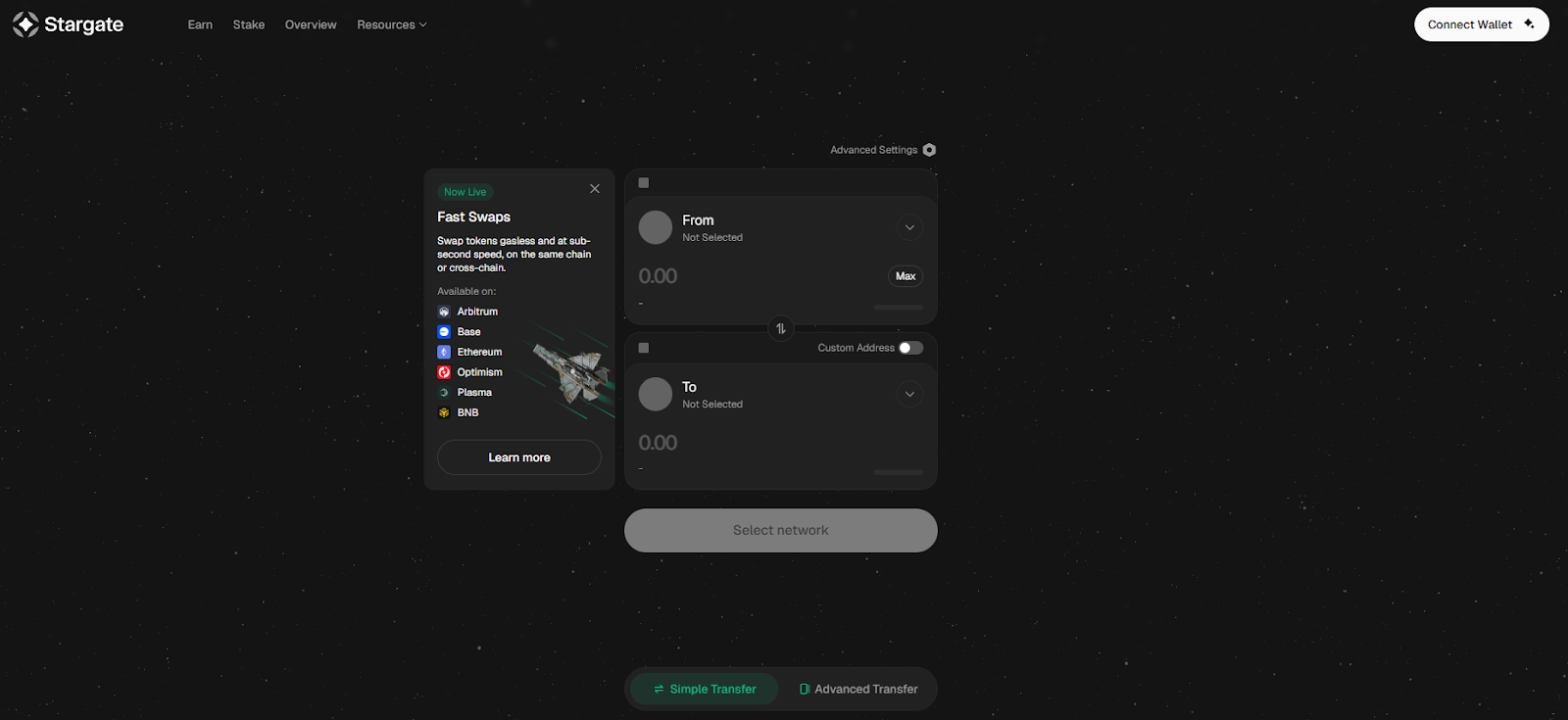
2. Synapse Protocol — Best for Speed Across 20+ Chains
Why Use It: Synapse combines liquidity pools with an optimistic verification model to deliver 2-5 minute average transfer times across 20+ networks, including Ethereum, Arbitrum, Optimism, Base, Polygon, BNB Chain, Avalanche, Fantom, Harmony, Moonbeam, and Aurora. Its nUSD and nETH synthetic assets enable efficient cross-chain swaps with competitive 0.05-0.3% fees, while the Synapse Bridge interface integrates one-click swaps for seamless UX.
Best For: Active traders prioritizing speed, multichain yield optimizers, NFT collectors moving assets, users bridging to emerging L2s.
Notable Features:
- Sub-5-minute average transfers with optimistic verification
- 20+ chain support including Base and zkSync Era
- Integrated DEX for same-transaction swaps
- Audited by Quantstamp, Certik, and Code4rena
Consider If: You move assets over $100K per transaction (liquidity depth varies by route) or need guaranteed finality before spending (optimistic delays possible).
Alternatives: Stargate Finance, Hop Protocol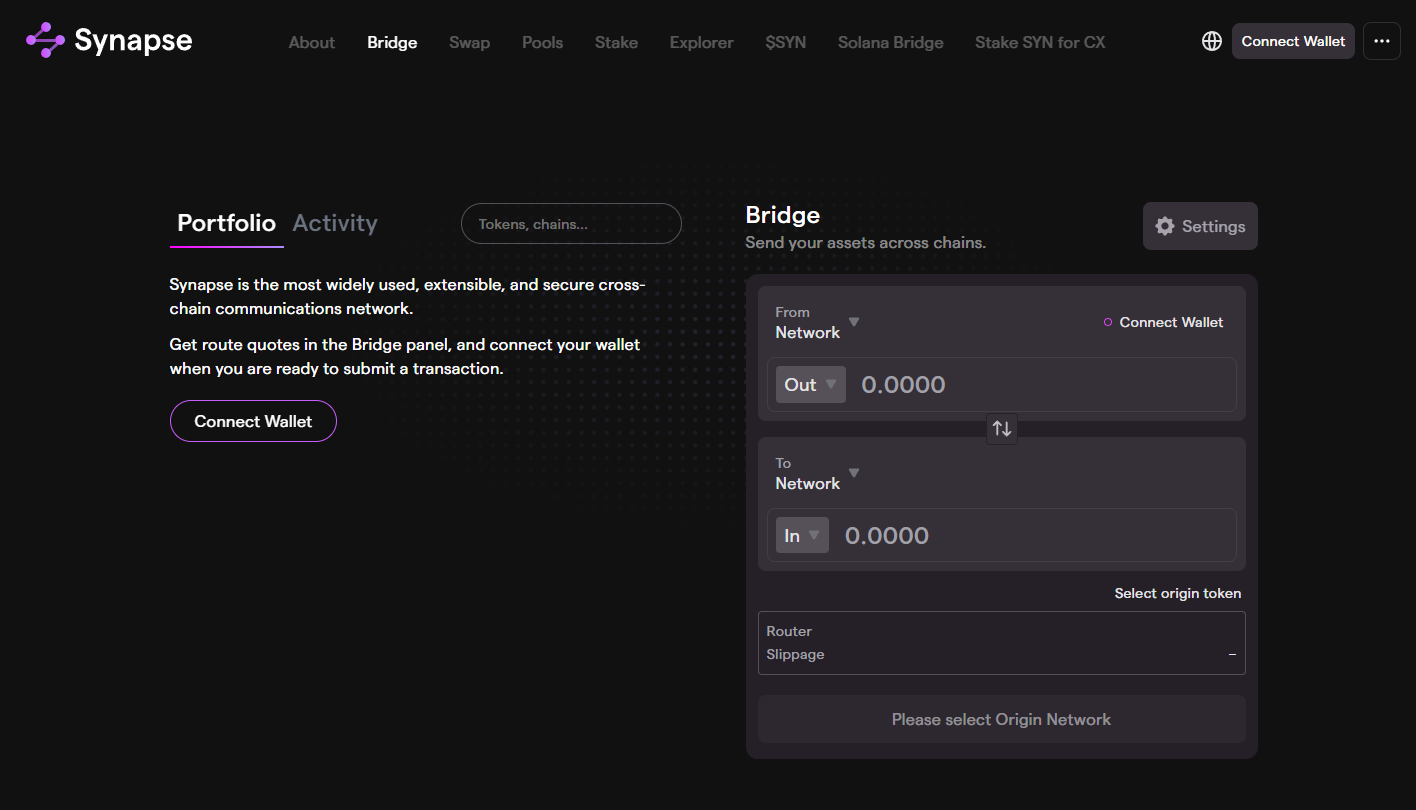
3. Across Protocol — Best for Optimistic Bridging & Low Slippage
Why Use It: Across uses UMA's optimistic oracle to facilitate near-instant transfers with relayers fronting capital and settling on the destination chain within 1-4 minutes. Traders enjoy 0.01-0.25% fees—among the lowest for EVM bridges—and minimal slippage on major routes like Ethereum to Arbitrum, Optimism, Polygon, and Base. The protocol's capital efficiency makes it ideal for arbitrageurs and high-frequency movers.
Best For: Arbitrage traders, gas-sensitive users, high-frequency DeFi participants, cost-conscious portfolio managers.
Notable Features:
- Optimistic verification for 1-4 minute transfers
- Ultra-low fees (0.01-0.25%) with transparent pricing
- Relayer network ensures liquidity without pool fragmentation
- Audited by OpenZeppelin and ABDK with ongoing bug bounty
Consider If: You need non-EVM chain support (currently EVM-only) or prefer liquidity-pool-based bridges for guaranteed execution.
Alternatives: Stargate Finance, Synapse Protocol
4. Wormhole — Best for Cross-Ecosystem Bridging
Why Use It: Wormhole is a generalized messaging protocol supporting 30+ blockchains including Ethereum, Solana, Terra, BNB Chain, Avalanche, Polygon, Fantom, Celo, and Cosmos-based chains. Its Guardian network of 19 validators enables lock-and-mint bridging for tokens and NFTs with no protocol fees beyond network gas costs. The recent Wormhole Connect widget simplifies integrations for traders using multichain dApps.
Best For: Cross-ecosystem traders (EVM to Solana/Cosmos), NFT collectors, developers integrating bridging, users of Wormhole-native dApps.
Notable Features:
- 30+ chain support including Solana, Terra, and Cosmos IBC
- Generalized messaging enables cross-chain smart contract calls
- Guardian network with 19 institutional validators
- Audited by Neodyme, Kudelski, and OtterSec post-2022 exploit recovery
Consider If: You prioritize speed over security guarantees (5-20 min transfers) or need the deepest liquidity per route (Stargate/Synapse stronger for stables).
Alternatives: Axelar, Celer cBridge
5. Celer cBridge — Best for 40+ Chain Coverage
Why Use It: Celer cBridge supports 40+ blockchains with a hybrid liquidity pool and state channel architecture, enabling 3-10 minute transfers at 0.04-0.2% fees. Its State Guardian Network provides security for cross-chain state verification, while the cBridge UI offers direct wallet integrations and historical transaction tracking. Recent additions include support for zkSync Era, Linea, and Scroll.
Best For: Multichain portfolio managers, traders accessing niche L2s, users bridging to gaming-focused chains, cost-conscious cross-chain swappers.
Notable Features:
- 40+ chains including zkSync, Linea, Mantle, and Scroll
- State Guardian Network for optimistic cross-chain verification
- Integrated liquidity mining for yield on idle bridge assets
- Audited by Certik, PeckShield, and SlowMist
Consider If: You operate in mainland China (limited access) or need guaranteed sub-5-minute finality (optimistic delays on congested routes).
Alternatives: Synapse Protocol, Axelar
6. Hop Protocol — Best for Ethereum L2 Bridging
Why Use It: Hop specializes in fast transfers between Ethereum mainnet and nine major L2s (Arbitrum, Optimism, Base, Polygon, zkSync Era, Linea, Scroll, Gnosis Chain, and Polygon zkEVM) using AMM-style liquidity pools and decentralized bonders who provide instant liquidity. Traders pay 0.04-0.25% fees and experience 10-30 minute average transfers, with the option to earn yield by providing liquidity or running bonder nodes.
Best For: L2-first traders, Ethereum mainnet to L2 bridgers, liquidity providers, users seeking decentralized bridge architecture.
Notable Features:
- Native L2 focus with support for 9 Ethereum L2s
- AMM-based liquidity pools for transparent pricing
- Decentralized bonder network reduces trust assumptions
- Audited by Consensys Diligence and OpenZeppelin
Consider If: You need to bridge to non-EVM chains (Ethereum ecosystem only) or require sub-10-minute finality consistently (bonder availability varies).
Alternatives: Synapse Protocol, Across Protocol
7. Axelar — Best for Cosmos & Proof-of-Stake Security
Why Use It: Axelar is a Cosmos SDK-based interoperability network with 75+ validators securing cross-chain transfers via proof-of-stake consensus. Supporting 50+ chains with IBC-native bridging to Cosmos, Osmosis, Injective, and other app-chains, Axelar enables secure general message passing for complex cross-chain dApp interactions at 0.1-0.5% fees. Transfers settle in 5-15 minutes with high finality guarantees.
Best For: Cosmos ecosystem traders, institutional users prioritizing security, developers building cross-chain dApps, users requiring verifiable bridge security.
Notable Features:
- 75+ decentralized validators with proof-of-stake security
- Native IBC support for Cosmos ecosystem chains
- General Message Passing (GMP) for cross-chain smart contracts
- Audited by NCC Group, OtterSec, and Certik
Consider If: You prioritize speed over security (5-15 min slower than optimistic bridges) or need the lowest fees per transaction (0.1-0.5% higher than Across/Stargate).
Alternatives: Wormhole, Celer cBridge
8. Multichain — Best for 80+ Chain Access (Use With Caution)
Why Use It: Multichain (formerly Anyswap) offers the broadest chain coverage with 80+ supported networks using SMPC (Secure Multi-Party Computation) signers for lock-and-mint bridging. While historically popular for accessing niche chains like Moonriver, Kava, and Metis, the protocol faced security concerns in mid-2023 related to validator key management. Fees range from 0.1-0.3% with 10-30 minute transfer times.
Best For: Users bridging to obscure chains unavailable elsewhere, legacy dApp integrations, traders willing to accept elevated risk for maximum coverage.
Notable Features:
- 80+ chain support including niche L1s and L2s
- Long operational history since 2020
- Cross-chain router for multi-hop transactions
- SMPC validator network (security incidents reported)
Consider If: Security is your top priority (2023 exploit drained $126M; ongoing validator concerns) or you need active development and transparent disclosures.
Alternatives: Celer cBridge, Axelar
9. Orbiter Finance — Best for L2-to-L2 Transfers
Why Use It: Orbiter uses a maker-taker model where centralized makers provide instant liquidity for L2-to-L2 transfers across 15+ chains including Arbitrum, Optimism, zkSync Era, StarkNet, Linea, Base, and Scroll. Transfers complete in 1-10 minutes at 0.05-0.3% fees, with ZK-proof verification planned for enhanced security. The interface is optimized for mobile and shows real-time maker liquidity status.
Best For: L2-native traders, StarkNet and zkSync users, mobile-first users, traders needing fast L2 exits.
Notable Features:
- Specialized L2-to-L2 focus with 15+ network support
- 1-10 minute average transfers via maker liquidity
- ZK-proof verification roadmap for trustless bridging
- Real-time liquidity tracking and maker status
Consider If: You prefer fully decentralized bridge models (makers are centralized) or need mainnet-to-L2 bridging exclusively (better alternatives exist).
Alternatives: Hop Protocol, Synapse Protocol
10. Meson Finance — Best for Atomic Swap Security
Why Use It: Meson implements hash time-locked contracts (HTLCs) for trustless atomic swaps across 20+ chains, eliminating validator risk and bridge contract vulnerabilities. Traders benefit from 2-8 minute transfers at 0.02-0.15% fees with cryptographic guarantees that transactions either complete or refund automatically. The protocol is audited by SlowMist and maintains zero-exploit history since launch.
Best For: Security-conscious traders, users burned by bridge exploits, atomic swap enthusiasts, traders moving mid-sized amounts ($1K-$50K).
Notable Features:
- HTLC-based atomic swaps for trustless bridging
- Zero-exploit record with cryptographic security guarantees
- 20+ chain support including major EVM and L2s
- 0.02-0.15% fees competitive with optimistic bridges
Consider If: You need to bridge large amounts over $100K (liquidity depth limited) or require sub-2-minute finality (HTLC setup adds overhead).
Alternatives: Across Protocol, Stargate Finance
Decision Guide: Best By Use Case
- Stablecoin arbitrage & DeFi yield: Stargate Finance for deepest USDC/USDT liquidity
- Fastest cross-chain execution: Synapse Protocol or Across Protocol for sub-5-minute transfers
- Ethereum L2 specialists: Hop Protocol for native L2 bridging with decentralized bonders
- Cross-ecosystem traders (EVM + Solana/Cosmos): Wormhole or Axelar for broadest coverage
- Lowest fees & slippage: Across Protocol for optimistic bridging at 0.01-0.25%
- Maximum chain coverage: Celer cBridge (40+) or Multichain (80+ with caution)
- L2-to-L2 focus (zkSync, StarkNet, Arbitrum): Orbiter Finance for maker-taker speed
- Security-first & trustless: Meson Finance for atomic swap guarantees
- Institutional security requirements: Axelar for proof-of-stake validator model
- Mobile-optimized bridging: Orbiter Finance or Synapse Protocol
How to Choose the Right Cross-Chain Bridge (Checklist)
- [ ] Verify chain support — Confirm both source and destination chains are supported with active liquidity
- [ ] Check fee transparency — Review total costs including bridge fees, gas, and potential slippage before confirming
- [ ] Assess security model — Understand validator architecture (optimistic, proof-of-stake, HTLC, multisig) and audit history
- [ ] Review transfer speed requirements — Match bridge speed (1-30 min) to your trading strategy urgency
- [ ] Confirm liquidity depth — For large transfers ($50K+), verify pool TVL and recent volume on your specific route
- [ ] Test with small amounts first — Always bridge test transactions ($10-$100) before moving significant capital
- [ ] Verify destination address format — Double-check address compatibility and network selection to avoid irreversible losses
- [ ] Monitor bridge status pages — Check for maintenance, paused routes, or congestion warnings before transacting
- [ ] Understand finality guarantees — Know if transfers are optimistic (reversible), instant (relayer-based), or cryptographically final
- [ ] Review regional restrictions — Confirm access from your jurisdiction (most bridges global; check compliance)
- [ ] Check exploit history — Research past security incidents and protocol responses (Wormhole 2022, Multichain 2023)
- 🚩 Red flags: Bridges with undisclosed validator sets, paused routes without status updates, or fees significantly higher than quoted
Use Token Metrics With Any Cross-Chain Bridge
Maximize your cross-chain trading strategy by combining bridge infrastructure with Token Metrics intelligence:
- AI Ratings screen 6,000+ tokens across chains to identify quality assets before bridging capital

- Narrative Detection spots emerging themes (e.g., Solana DeFi, Base ecosystem) to inform which chains to bridge into
- Portfolio Optimization balances risk across chains and suggests rebalancing targets that justify bridge costs
- Alerts & Signals time bridge transactions around momentum shifts, reducing exposure to unfavorable price action mid-transfer
Workflow: Research asset quality with AI Ratings → Select optimal bridge for your route → Execute transfer → Monitor destination chain with real-time alerts.
Start your free trial to screen assets and time bridge transactions with AI-powered intelligence.
Security & Compliance Tips
- Verify official URLs — Always access bridges through bookmarked official domains; phishing sites are common
- Use hardware wallets — Sign bridge transactions with Ledger/Trezor for cold-storage protection
- Check token approvals — Revoke unlimited approvals after bridging using tools like Revoke.cash
- Monitor bridge exploits — Follow protocol Twitter accounts and status pages for real-time security alerts
- Understand validator risks — Multisig and SMPC bridges concentrate risk; optimistic and PoS models distribute trust
- Avoid bridging during congestion — High gas fees and slippage increase during network congestion; wait for off-peak times
- Store bridge receipts — Save transaction hashes and screenshots for tax reporting and dispute resolution
- Test cross-chain contract calls — If using advanced features (e.g., Axelar GMP), test with minimal amounts first
- Review liquidity provider risks — Impermanent loss and smart contract risk apply to bridge LPs; understand before depositing
- Know refund procedures — Understand each bridge's failed transaction refund process and timeframes
This article is for research and educational purposes, not financial advice. Conduct your own security due diligence before bridging assets.
Beginner Mistakes to Avoid
- Bridging to the wrong network — Always triple-check destination chain selection; wrong-network transfers are often irreversible
- Ignoring slippage on large transfers — Pools with <$10M TVL may experience 1-5% slippage on $100K+ transactions
- Bridging illiquid tokens — Ensure destination chain has DEX liquidity before bridging obscure tokens
- Not accounting for gas on destination chain — Bridge enough native tokens (ETH, MATIC, etc.) to pay for transactions on arrival
- Trusting wrapped tokens blindly — Verify wrapped token contracts are legitimate before swapping (scam tokens common)
- Bridging during protocol upgrades — Avoid bridging when protocols announce maintenance windows or upgrades
- Falling for "instant bridge" scams — No legitimate bridge offers instant finality across all chains; be skeptical of unrealistic claims
- Ignoring bridge insurance options — Services like Nexus Mutual offer bridge exploit coverage for eligible protocols
FAQs
What is a cross-chain bridge?
A cross-chain bridge is a protocol that enables asset transfers between different blockchains by locking tokens on the source chain and minting or unlocking equivalent tokens on the destination chain. Bridges use various security models including lock-and-mint, liquidity pools, optimistic verification, and atomic swaps to facilitate interoperability.
Are cross-chain bridges safe?
Bridge security varies significantly by architecture and track record. Bridges secured by proof-of-stake validators (Axelar) or atomic swaps (Meson) offer stronger security than multisig or SMPC models. Historical exploits affecting Wormhole ($325M in 2022) and Multichain ($126M in 2023) highlight risks. Always verify audit reports, exploit history, and validator transparency before bridging significant amounts.
How much do cross-chain bridges cost?
Bridge fees typically range from 0.01% to 0.5% of transfer amount, plus source and destination chain gas fees. Stargate and Across charge 0.01-0.06% for stablecoins, while Axelar charges 0.1-0.5% for broader coverage. Total costs including gas often range from $5-$50 for typical transactions, but can exceed $100 during Ethereum mainnet congestion.
Can I bridge any token between any chains?
No—token bridging depends on protocol support and liquidity availability. Major tokens (USDC, USDT, ETH, WBTC) have deep liquidity on most bridges, while obscure tokens may only bridge via wrapped versions or not at all. Always verify token support on both source and destination chains before attempting transfers.
How long do cross-chain bridge transfers take?
Transfer times range from 1 minute (Across optimistic transfers) to 30+ minutes (Hop during congestion or Multichain on slower chains). Average speeds: Across 1-4 min, Synapse 2-5 min, Stargate 1-15 min, Wormhole 5-20 min. Optimistic bridges are fastest but may delay finality during disputes; lock-and-mint bridges prioritize security over speed.
Do I need native tokens on the destination chain before bridging?
Not for the bridge transaction itself, but you'll need native tokens (ETH on Ethereum, MATIC on Polygon, etc.) to pay gas for any subsequent transactions on the destination chain. Some bridges offer small gas token bridging or faucet integrations, but plan to bridge sufficient native tokens alongside your primary assets.
What happens if my bridge transaction fails?
Failed transactions typically result in automatic refunds to the source address within 24-72 hours, though timelines vary by protocol. Optimistic bridges may take longer during dispute periods. Always save transaction hashes and monitor bridge status pages for updates. Contact protocol support via Discord or Telegram for transactions stuck beyond normal timeframes.
Can I use bridges for NFTs or only fungible tokens?
Most bridges focus on fungible tokens (ERC-20, SPL, etc.), but several support NFT bridging. Wormhole enables NFT transfers across 30+ chains, while specialized solutions like Axelar and Celer support NFT metadata preservation. NFT bridges often charge fixed fees ($5-$20) regardless of NFT value and may take longer than fungible token transfers.
Conclusion + Related Reads
Selecting the right cross-chain bridge depends on your priorities: Stargate Finance delivers the deepest stablecoin liquidity for DeFi-focused traders, Synapse Protocol offers the fastest execution across 20+ chains, and Across Protocol provides the lowest fees for cost-conscious arbitrageurs. Security-first users should consider Meson Finance for atomic swap guarantees or Axelar for institutional-grade proof-of-stake validation. Always test with small amounts, verify destination addresses, and monitor bridge status pages before moving significant capital.
Related Reads:


Get Your Brand in Front of 150,000+ Crypto Investors!




 Create Your Free Account
Create Your Free Account9450 SW Gemini Dr
PMB 59348
Beaverton, Oregon 97008-7105 US
.svg)
No Credit Card Required


Online Payment


SSL Encrypted
.png)
Products
Subscribe to Newsletter
Token Metrics Media LLC is a regular publication of information, analysis, and commentary focused especially on blockchain technology and business, cryptocurrency, blockchain-based tokens, market trends, and trading strategies.
Token Metrics Media LLC does not provide individually tailored investment advice and does not take a subscriber’s or anyone’s personal circumstances into consideration when discussing investments; nor is Token Metrics Advisers LLC registered as an investment adviser or broker-dealer in any jurisdiction.
Information contained herein is not an offer or solicitation to buy, hold, or sell any security. The Token Metrics team has advised and invested in many blockchain companies. A complete list of their advisory roles and current holdings can be viewed here: https://tokenmetrics.com/disclosures.html/
Token Metrics Media LLC relies on information from various sources believed to be reliable, including clients and third parties, but cannot guarantee the accuracy and completeness of that information. Additionally, Token Metrics Media LLC does not provide tax advice, and investors are encouraged to consult with their personal tax advisors.
All investing involves risk, including the possible loss of money you invest, and past performance does not guarantee future performance. Ratings and price predictions are provided for informational and illustrative purposes, and may not reflect actual future performance.



%201.svg)

